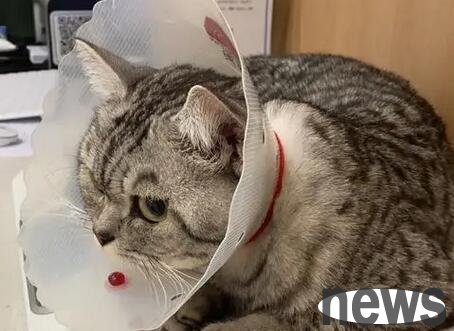Many cat owners will encounter this problem. The cat no longer urinates in the cat litter, urinates anywhere on the ground, and urinates frequently and urinates hemorrhage. In the past, people always regarded hematuria and frequent urination as bloc...
Many cat owners will encounter this problem. The cat no longer urinates in the cat litter, urinates anywhere on the ground, and urinates frequently and urinates hemorrhage. In the past, people always regarded hematuria and frequent urination as blockage of stones, but in fact, 50% of them were caused by idiopathic cystitis! With the increasing development of medicine, we should also have a new understanding of cystitis.
What is cystitis?
Urgent tract problems in cats include many causes, such as urinary tract infection, sterile or idiopathic cystitis, urinary tract stones, cancer, rupture or congenital problems, as well as other organs or body systems problems. Among them, idiopathic cystitis is one of the more common lower urinary tract diseases in cats, and the professional term is FIC.

cystitis is mainly caused by bladder inflammation caused by pathogenic microbial infection, the spread of inflammation in the neighboring organs, and irritation or damage to the bladder mucosa. Among them, "idiopathic" means that the reason for this condition cannot be determined at present. Although cystitis refers to the inflammation of the bladder, there are many causes of cystitis, such as urinary tract infection, urinary tract cancer and bladder stones, all may be caused. Both male and female cats may suffer from cystitis, which is a relatively difficult chronic disease to treat.
What are the symptoms of cystitis?
· Frequent urination
· Do urination posture
· Do not urinate in the cat litter box
· The urine contains blood, blood clots and mucus, etc.
· Pain is very small or drip-like, and the urine is turbid, with a strong ammonia odor
· Palpation of bladder pain
· Body temperature rise, depression, loss of appetite, etc. (When inflammation affects tissues or is accompanied by nephritis, ureteritis)
Note: The clinical manifestations of cystitis can also be divided into blocked and non-blocked types, each category has different manifestations and symptoms, and a preliminary judgment can be made. After the next step of the test and the medical history, more accurate pathogen screening can also be performed through other tests.
What causes cystitis?
Although cystitis is a disease that cannot be treated accurately, these abnormal phenomena are very common possible factors among patients with cystitis.
· Problems with inner wall of bladder
The cell layer of the bladder is a mucus layer composed of glycated proteins that can protect the fragile cells of the bladder wall. Because urine contains many high concentrations of substances, without these protections, it will stimulate cells. Judging from cats with cystitis, this inner wall is defective. It may damage the cells of the bladder, causing irritating inflammation to occur.
· Neurogenic inflammation
Neurogenic inflammation
Neurosinus in the bladder wall may be locally stimulated by the inner wall of the bladder, or stimulated by the brain (pressure). These nerve stimulation causes the release of neurotransmitters, thereby aggravating local inflammation and pain.
· Stress
In cats with cystitis, many things are caused by stress. Although it is difficult to directly correlate, many signs indicate that cats locked indoors alone, or cats from multiple cats, are high-incidence examples of cystitis.
· Abnormal stress response
There is sufficient evidence to suggest that cats are affected by stress and can stimulate cystitis, and stress usually reaches the release of adrenaline, methephinine and cortisol. In cats with cystitis, they actually have lower than normal cortisol reactions.
· Water deficiency in cat food
When the water content of cat food is 8%-10%, it is already a lack of water. At this time, the cat will produce more concentrated urine, and the amount of urine will also decrease, causing stones to occur and eventually cystitis. And many urinary tract prescription foods currently have extremely high carbohydrate amounts, and we should choose carefully. Although diet is not the only way to control cystitis, it is a point we can control.
How to diagnose cystitis?
There is currently no diagnostic test that can directly confirm that cats have cystitis. They can only make judgments by excluding other diseases that may cause similar symptoms, cats' medical history, clinical symptoms, changes in bladder palpation and urine test results.
· Urine examination
Urine examination is the most important diagnostic step, including blood, crystals, proteins and other abnormal substances, and testing pH. When there are a lot of white blood cells in the urine and appear cloudy, it is pyuria, and when it is brown, it is hematuria, which has an ammonia odor. When bacteria are found in the urine, it means that the bladder has been infected. When fungus is found in urine, fungal urine appears, indicating that it has been infected by fungal infection. If pyuria, hematuria, proteinuria and bacterial urine appear at the same time, it means that it is a urinary tract infection.

· Blood test
includes complete blood cell counts and chemical characteristics. Generally speaking, cystitis has no increase in leukocytes and neutrophils shift left. These differences can be different from pyelonephritis and prostatitis.
· X-ray examination: An abdominal X-ray or ultrasound examination of the bladder to eliminate stones and other abnormal structures in the bladder. This test can diagnose some complications, such as urinary stones, tumors, urethral abnormalities, intravesical diverticulum and chronic cystitis. What is the treatment method for cystitis? The following is for reference only. The specific medication conditions must be subject to the plan given by the doctor after diagnosis.
· Improve diet
Let the cat have proper rest, feed high-quality foods that are non-irritating and nutritious, and ensure sufficient and clean water sources. And reduce the intake of high-protein things.
· Clean the urination port
First, rinse the bladder repeatedly with warm saline, and then rinse with medicine solution. For example, for the purpose of disinfection, 0.1% potassium permanganate solution (or 2% boric acid solution and 0.02% furacillin solution) can be used. For astringency, 1%~2% alum solution (or tannin solution) can be used.. For chronic cystitis, 0.02% to 0.1% silver nitrate solution can be used.
· To control infection/eliminate inflammation
Antibiotics, quinolones, sulfonamides and antifungal drugs can be used. In severe cases of bleeding, systemic hemostatic drugs can be used, such as adrenal chromostomy (Anluo blood) 0.1~0.3 mg/kg, twice a day. Or phenolsulfoethylamine (hemostatic sensitivity) 5~15 mg/kg, twice a day, intramuscular injection.
· Increase the amount of water
Once cats are in the condition of concentrating urine and difficulty urinating, they will increase the burden on the kidneys. When they eat cat food with water, the amount of urine will be less and it is easy to produce stones. Therefore, they should increase their water consuming and improve cat food to dilute urine to improve the condition.
Effective prevention methods
· Increase the amount of water to drink, and drinking more water can help dilute the urine, thereby accelerating the symptoms;
· Put a few more clean water bowls in the room, or prepare a fountain or drip water dispenser;
· Do not directly refer to tap water;
· Provide a sufficient number of cat litter box, one for one for a cat;
· Keep the litter box dry and tidy;
· Put the litter box in a quiet position to avoid disturbing the cat during use;
· Eating cans can help cats increase the amount of water used
· Reduce stress status to relieve cats' stress, especially for families with multiple cats.
Warm tip:
Many people think cystitis is an easy-to-treat disease, but if the urethra is obstructed and the inability to urinate, it can even be life-threatening. Therefore, during the treatment process, if new symptoms appear or still feel uncomfortable, you need to contact a doctor immediately to prevent recurrent cystitis; long-term management is also very important, so be sure to complete the entire treatment process according to the doctor's instructions.